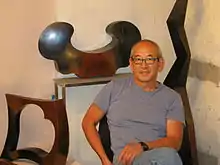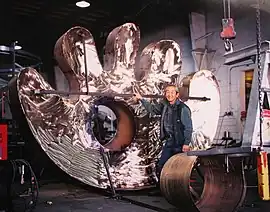Gerard Tsutakawa
Gerard "Gerry" Tsutakawa (born 1947), son of artist George Tsutakawa, is an accomplished Pacific Northwest sculptor. A studio apprentice for his artist father for 20 years, Gerry created his own first commissioned work in 1976. In the same studio where his father worked, he continues to design and fabricate anything from small studio bronze pieces to large public art fountains and sculptures.
Gerard Tsutakawa | |
|---|---|
 Gerard Tsutakawa with some of his smaller artworks at home studio | |
| Born | 1947 Seattle, Washington, United States |
| Nationality | American |
| Known for | Sculptor |
| Parent |
|
| Website | https://www.gerardtsutakawa.com |
History of artwork

Past sculpture projects include the Urban Peace Circle Memorial at Sam Smith Park in 1994, a collaboration with the Stop the Violence Committee where Tsutakawa contributed a 9-foot (2.7 m) bronze sculpture to the City of Seattle, in memory of youth who have died by handgun violence. In 1999, Tsutakawa created The Mitt for Safeco Field[1][2] and in 2000 the Fountain of Seseragi at the Seattle Center.
Recent commissions include the Salish Sea Circle in Port Townsend, bronze entrance gates for Seattle Park’s Kubota Garden and the Washington Park Japanese garden, the Annie Curtis sculpture at the Port of Anacortes, Uzumaki Curve in St Louis, and Thunderbolt at Union Plaza in downtown Seattle.
Tsutakawa continues to work on public and private commissions around the Northwest and across the nation.
References
- Guo, Ann (September 3, 2021). "Gerard Tsutakawa's sculptures have shaped Seattle's landscape for years. Here's how — and what else is coming". The Seattle Times. Retrieved February 7, 2022.
These formal elements became more focused as Gerard evolved his discipline. He installed larger and more ambitious works across King County over the next 40 years. In 1999, Gerard created "The Mitt" for Safeco Field (now T-Mobile Park), where it has since stood as a landmark, meeting point and photo opportunity for citygoers near and far.
- Sillman, Marcie (December 4, 2017). "Do you know the family story behind Seattle's beloved baseball mitt?". KUOW-FM. Retrieved February 7, 2022.
Seattleites have indeed embraced this sculpture; its surface is worn away in the spots where people climb on it to have their pictures taken. "The Mitt" has become a city icon, like the Fremont Troll or the Pike Place Market pig.